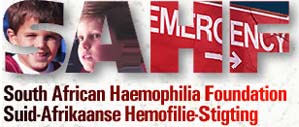South African Haemophilia Foundation
Haemophilia is an inherited lifelong bleeding disorder, affecting only males with females being carriers. The condition causes dangerous haemorrhages internally and into the joints and muscles, resulting in severe pain and eventually causing crippled limbs. It leads to interrupted education and eventual difficulties in obtaining and keeping employment. Frustration and depression so engendered can be the cause of social difficulties.
Haemophilia was known in Biblical times, and more interest is evidenced in the fate of the Ramanovs of Russia and the Burbons of Spain. The incidence is estimated at approximately 0.01% of any population. In addition, no community or family is guaranteed immunity, since haemophilia may arise by mutation as well as inheritance.
The condition demands medical and social attention out of all proportion to its frequency, placing considerable financial demands on both affected families and Provincial health services. Haemophilia is not curable. Effective treatment has become available only in the last two decades, mainly due to the improvement of technology to extract the relevant protein from donated blood and administering it to the affected individuals. Unfortunately, this has brought about an additional worry to persons with haemophilia, who in their treatment necessarily have to consume large quantities of blood and blood related products. This has come about by the advent of HIV and Aids. Some persons with haemophilia were infected with the HIV virus, due to a small percentage of donated blood having been contaminated. Although the screening, testing and modern methods of sterilisation of all donated blood prior to usage, has improved to such an extent that no case of infection is known since these methods have been employed, the thought does place additional social strain on the families concerned.
A related condition, Von Willebrands disease, also occurs, and this condition manifests itself in both males and females. Its incidence and effect on lives of those affected are not usually as severe as is the case with haemophilia.
In June 1970, a national congress was held in East London and the South African Haemophilia Foundation came into being and shortly thereafter was admitted to the membership of the World Federation of Haemophilia. The foundation is comprised of seven voluntary committees for the Western Cape, Eastern Cape, KwaZulu Natal, Free State, North and Central Regions. The Foundation has as its mission:
- To provide a fellowship for persons with haemophilia and similar conditions, for their families and those concerned in their health and welfare.
- To promote the interests of persons with haemophilia and similar conditions.
- To, where possible and within the means of the Foundation, financially assist persons with haemophilia and similar conditions needing such assistance.
- To strive to facilitate adequate treatment facilities and access to safe products for the treatment of haemophilia at the best financial dispensation possible.
- To render its services in the Republic of South Africa.
